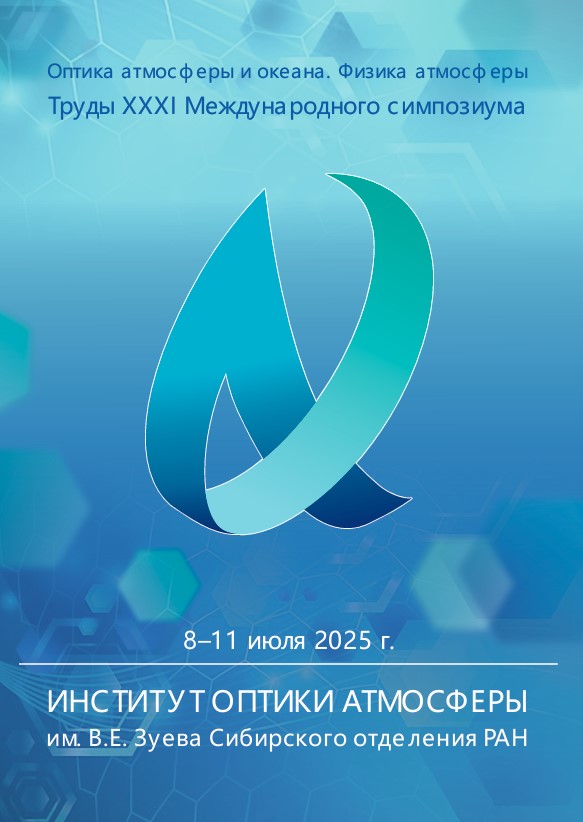UDC 535
CSCSTI 29.31
Russian Classification of Professions by Education 12.00.00
Russian Library and Bibliographic Classification 22
Russian Trade and Bibliographic Classification 61
BISAC SCI053000 Physics / Optics & Light
During long-term measurements at the Siberian lidar station of the Institute of Atmospheric Optics SB RAS on February 5-6, 2025, pronounced aerosol layers were recorded in the stratosphere of Tomsk. Analysis of lidar and additional meteorological information showed that at that time, a rather rare phenomenon for mid-latitudes was observed - polar stratospheric clouds. These clouds, according to the data obtained, can be classified as type I clouds. The constructed reverse trajectories of air mass movement at the altitudes of formation of polar stratospheric clouds over Tomsk showed that anomalously cold air masses were brought from the polar regions of Norway and Greenland.
remote sensing, lidar, stratospheric aerosol
1. Zuev V. V., Smirnov S. V. Rezul'taty kompleksnyh nablyudeniy ozonnyh anomaliy na Sibirskoy lidarnoy stancii (SLS, 56,5ºs.sh., 85ºv.d.) . // Optika atmosfery i okeana. 1997. T. 10. № 12. S. 1400-1414.
2. Zuev V.V., Burlakov V.D., Nevzorov A. V., Pravdin V. L.,. Savelieva E. S, and Gerasimov V. V. 30-year lidar observations of the stratospheric aerosol layer state over Tomsk (Western Siberia, Russia) // Atmospheric Chemistry and Physics. 7, 3067–3081, 2017. doihttps://doi.org/10.5194/acp-17-3067-2017
3. Cheremisin A. A., Marichev V. N., Novikov P. V. Perenos polyarnyh stratosfernyh oblakov iz Arktiki k Tomsku v yanvare 2010 g. // Optika atmosfery i okeana. 2013. T. 26. № 02. S. 93-99.
4. Bazhenov O. E., Nevzorov A. A., Nevzorov A. V., Dolgiy S. I., Makeev A. P. Vozmuschenie stratosfery nad Tomskom zimoy 2017/2018 gg. po dannym lidarnyh i sputnikovyh (Aura MLS/OMI) nablyudeniy. // Optika atmosfery i okeana. 2020. T. 33. № 07. S. 509–515. DOI:https://doi.org/10.15372/AOO20200702.
5. Solomon S. Stratospheric ozone depletion: A review of concepts and history. Rev. Geophys., v.37, N 3, p.275-316, 1999.
6. Saitoh N., Hayashida S., Sasano Y., Pan L.L. Characteristics of Arctic polar stratospheric clouds in the winter of 1996/1997 inferred from ILAS measurements. J. of Geophysical Research-Atmospheres, v.107, D24, p.8205, 2002.
7. Seinfeld J.H., Pandis S.N. Atmospheric chemistry and physics. From air pollution to climate change. John Wiley & Sons, Inc., New York-Chichester-Weinheim-Brisbane-Singapore-Toronto, 1326 p., 1998.
8. Strawa A.W., Drdla K., Fromm M., Pueschel P.F., Hoppel K.W., Browell E.V., Hostetler C.A., Hamill P. Discriminating types Ia and Ib polar stratospheric clouds in POAM satellite data. J. Geophys. Res., v.107, D20, p.8291, 2002.
9. Vargin P.N., Kostrykin S.V., Rakushina E.V., Volodin E.M., Pogorel'cev A.I. Issledovanie izmenchivosti dat vesennih perestroek cirkulyacii stratosfery i parametrov stratosfernogo polyarnogo vihrya v Arktike po dannym modelirovaniya i reanaliza // Izvestiya Rossiyskoy akademii nauk. Fizika atmosfery i okeana. 2020. T. 56. № 5. S. 526-539.
10. Nevzorov A. V., Dolgiy S. I., Makeev A. P., El'nikov A. V. Rezul'taty lidarnyh nablyudeniy aerozolya ot lesnyh pozharov Severnoy Ameriki v stratosfere nad Tomskom v konce leta i osen'yu 2017 g. // Optika atmosfery i okeana. 2019. T. 32. № 02. S. 162–167. DOI:https://doi.org/10.15372/AOO20190211.





